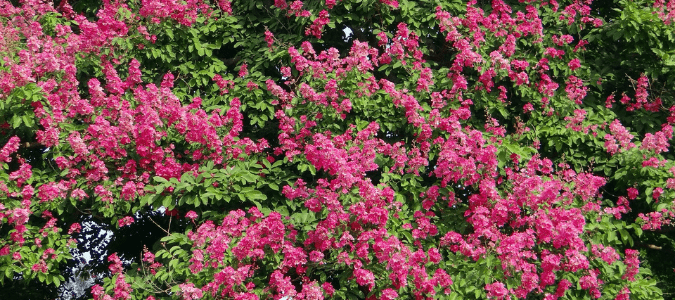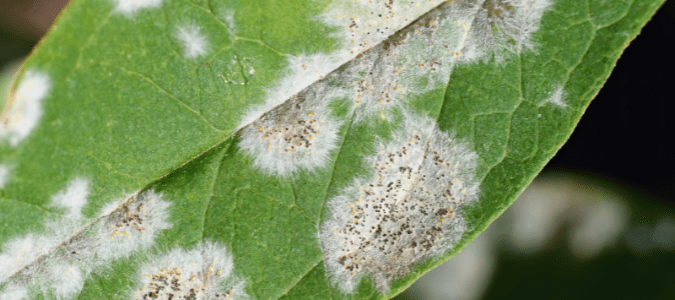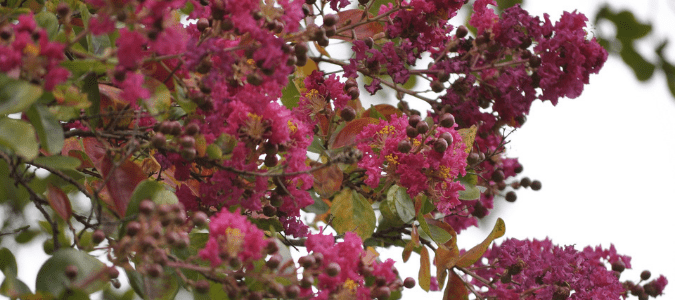Throughout late spring and summer, you may notice trees with multiple slender trunks that have smooth bark, green leaves and branches bursting with clusters of frilly blooms. These trees are crape myrtles, and they add gorgeous splashes of color to any landscape. There are many different types of crape myrtles, so their flowers can range from white to blush pink to cranberry red and even vibrant purple.
These trees also do well in small, confined spaces. They can thrive even when planted in a small strip of yard between the sidewalk and the street, for example. Their versatility makes them a great addition to almost any outdoor space.
In some yards, crape myrtles look more like bushes or shrubs than trees. This may be because they are still young, but it could also be due to the particular variety. The different types of crape myrtles grow to varying heights, ranging from just a few feet tall to 30 or even 40 feet.
Miniature crape myrtles, for example, grow to just a few feet tall. Many gardeners like to plant these in a mulched bed, either alone or surrounded by other bushy plants. Other varieties can grow far taller, stretching to between 20 and 40 feet at their full, mature height. Still other varieties can grow to almost any height in between.
Most varieties of crape myrtle do well in climates that get plenty of heat and sun. These trees can also handle moderate drought once their roots are established, which only takes a couple of years. They are also disease-resistant. All of these qualities make them a low-maintenance and appealing choice for almost any size of yard or outdoor space.
New types of crape myrtles crop up regularly, as horticulturists cross varieties to create new hybrids. These hybrids are often aimed at better mildew resistance. Powdery mildew is a fungal growth that can affect crape myrtles, leaving a grayish residue on their leaves. Higher mildew resistance is preferable.
Choosing a crape myrtle first by height and then by bloom color is the best way for most people to make sure they get the right crape myrtle for their needs. Here is a look at various common types of crape myrtles, including their heights, bloom colors, level of mildew resistance and other standout qualities.
Miniature Varieties of Crape Myrtles
Miniature crape myrtles are also referred to as “weeping” or “very dwarf” varieties. They are the smallest crape myrtles, growing to a maximum of three feet tall. They make attractive groundcover or small bushes in mulched garden beds.
- Pixie White: These plants grow to 2 to 3 feet tall and bear white blooms.
- Baton Rouge, Bourbon Street, Chickasaw, Creole, Sacramento, Tightwad and World’s Fair: These grow to roughly 2 to 3 feet tall and bear red blooms. All have fair resistance to mildew except the Chickasaw, Sacramento and Tightwad varieties. The Sacramento has better-than-average resistance to mildew, and its leaves also turn red in autumn. The Chickasaw and Tightwad both have high mildew resistance. The Chickasaw typically grows to only 1 to 2 feet tall, while the Tightwad grows to 2 to 4 feet.
- Bayou Marie, Delta Blush, Pink Blush and Pokomoke: These reach 2 to 3 feet tall, with light pink to deep pink blooms. All have fair mildew resistance except the Pokomoke, which has somewhat higher resistance.
- Cordon Bleu, Lafayette, New Orleans and Velma’s Royal Delight: These grow to 2 to 3 feet in height, with lavender or purple blooms. All have fair mildew resistance except the Velma’s Royal Delight. Its mildew resistance is better than average; its leaves also turn yellowy-orange in autumn, and it can grow up to four feet tall.
The Pokemoke and Velma’s Royal Delight typically grow well in Texas yards. It’s important to note, though, that most miniature crape myrtles aren’t quite as hardy as taller varieties. They might need more careful watering and other interventions to thrive.
Dwarf Varieties of Crape Myrtle
Dwarf crape myrtles reach a mature height of three to six feet tall. They make good ornamental additions to small spaces, such as planted at regular intervals along a driveway or sidewalk.
- Hope, Petite Snow and Dwarf Snow: These grow 4 to 6 feet tall and bear white blooms. Their mildew resistance is fair.
- Petite Embers, Petite Red Imp and Victor: These varieties all have red blooms. The Petite Embers and Petite Red Imp both grow to 4 to 6 feet tall, with fair resistance to mildew. The Victor grows to 3 to 5 feet tall, and has good mildew resistance.
- Berry Dazzle, Chica Pink, Chickasaw and Dwarf Pink Ruffles: These grow to be 4 to 6 feet tall with pink blooms. They have good mildew resistance.
- Centennial, Dwarf Royalty, and Petite Orchid: These varieties boast vibrant purple blooms. The Centennial and Dwarf Royalty varieties grow to 4 to 6 feet tall, with fair mildew resistance. The Petite Orchid can reach eight feet tall and has good mildew resistance.
The best dwarf crape myrtles for Texas yards and gardens are the Chickasaw, Petite Red Embers, Petite Red Imp, Petite Orchid and Petite Snow varieties.
Semi-Dwarf Varieties of Crape Myrtle
Semi-dwarf crape myrtles, also known as intermediate varieties, grow to a mature height of 5 to 12 feet tall.
- Acoma: These grow 6 to 12 feet tall and bear white blossoms. Their mildew resistance is high.
- Cheyenne, Christiana, Mandi and Tonto: These varieties grow roughly 8 to 12 feet tall and bear bright to dark red blooms. The Cheyenne and Tonto have high mildew resistance, while the Christiana and Mandi have fair resistance.
- Hopi and Pecos: These varieties grow to 8 to 12 feet tall and boast pink blooms. The Hopi and Pecos both have high resistance to mildew.
- Zuni: This variety grows to over 10 feet tall with violet blooms. Its mildew resistance is high.
The Acoma, Cheyenne, Tonto, Hopi and Zuni varieties are all good landscaping plants for Texas yards and gardens.
Medium Varieties of Crape Myrtle
These varieties are considered small trees, as they grow to between 10 and 20 feet in height.
- Carolina Beauty and Raspberry Sundae: These varieties grow to 15 to 20 feet tall with deep red blooms. Both have good resistance to mildew.
- Comanche, Near East, Osage and Sioux: Most of these varieties grow 15 to 20 feet high, with light to deep pink blooms and moderate to high mildew resistance. The Sioux grows 12 to 15 feet tall with medium-pink blossoms and high mildew resistance.
- Catawba, Lipan and Twilight: These varieties have violet or lavender blooms. The Catawba grows 12 to 15 feet tall with good mildew resistance. The Lipan grows to 15 to 20 feet tall with high resistance to mildew. The Twilight also grows to 15 to 20 feet tall, but with fair mildew resistance.
The best medium-height crape myrtles for Texas yards and gardens are the Osage and Lipan varieties.
Tall Varieties of Crape Myrtle
These are the tallest varieties of crape myrtle. They grow to over 20 feet in height, some soaring to 30 or even 40 feet tall.
- Natchez and Sarah’s Favorite: These grow 20 to 30 feet tall with white blossoms, and have high mildew resistance.
- Biloxi, Miami and Tuscarora: With light to dark pink blossoms, Biloxis grow over 30 feet tall, while Miamis and Tuscaroras grow to over 20 feet tall. All have high resistance to mildew.
- Arapaho, Dallas Red, Dynamite and Red Rocket: With red blooms, these trees all grow over 20 feet tall and are highly resistant to mildew.
- Basham’s Party Pink and Muskogee: These trees grow over 25 feet tall, with lavender blooms. They have good to high mildew resistance.
The native Texas trees that work best for yards are the Arapaho, Biloxi, Red Rocket and Sarah’s Favorite varieties.
If you’re having trouble deciding which crape myrtle will work best in your yard, it’s a great idea to reach out to a landscaping specialist. A pro can help you choose the right size and color of crape myrtle for your outdoor space. They can also save you labor by planting the trees and helping it to establish its roots. In time, it will become the perfect, beautiful and low-maintenance addition to your yard.
How to Treat Crape Myrtle Fungus
Their brightly colored flowers aren’t the only things that make crape myrtles beautiful. They also have gorgeous, deep-green leaves that create an attractive contrast with their blooms. But there are several types of crape myrtle fungus that can damage growing plants.
Powdery Mildew
The most common type of crape myrtle fungus is called powdery mildew, because the fungal growth leaves a whitish or gray-colored powdery residue on the plant’s leaves and flower buds. If it isn’t treated, the flower buds may not open and might even drop off. The plant’s overall growth could also be stunted.
Young plants are most often affected by powdery mildew. This fungus strikes in spring and early summer, when it is carried on the wind from one infected plant to another. Using fertilizer with too much nitrogen content can make crape myrtles more susceptible to powdery mildew. Warm, humid days and cooler nights are also prime conditions for crape myrtle fungus to grow and spread. The fungus has a hard time surviving or spreading in hotter and drier weather.
Sooty Mold
If your crape myrtle’s leaves look blackish instead of white or gray, they might have a fungal infection called sooty mold. This fungus happens when insects like aphids or leafhoppers live in the crape myrtle and secrete a substance that sooty mold grows on. The best treatment for this fungus is to get rid of the insects by blasting them off with the hose or using insecticidal products.
Cercospora
Crape myrtles can also be prone to a leaf spot fungus called Cercospora. This fungus causes brown spots on leaves. The leaves then prematurely turn red or yellow, and fall off the tree before autumn arrives. Like powdery mildew, this fungus grows in damp, humid conditions. This is one reason why crape myrtles should be planted in areas with full sun and soil with good drainage.
If your crape myrtle is struggling and you aren’t sure why, it’s a good idea to call in a landscaping professional who has experience with crape myrtles. They will be able to identify the problem and develop a plan for treatment, to restore the tree to its natural beauty and good health. They can also recommend the right spots in your yard for planting crape myrtles to give them their best chance at thriving without fungus problems creeping in.
When to Plant Crape Myrtle Trees
Wondering when to plant crape myrtle trees? Lots of people plant crape myrtles in summer because that’s when these plants bloom. It’s easiest to see what color of flowers you’re getting when you can see them in bloom at the nursery. But the best time of year to plant a crape myrtle is really in fall or early spring. If you do plant crape myrtles in summer, be sure to irrigate with plenty of water so they can establish their roots.
As your crape myrtle grows, it will likely grow multiple trunks, or shoots. These can be selected by choosing the strongest, best-placed ones to keep, and cutting back the rest. Just be sure to research how to trim a crape myrtle.
If you aren’t sure about when or how to plant your crape myrtles or how to care for them once they’re in the ground, reach out to a landscape specialist for help. A pro will be able to assist with every stage, from choosing the right plants and the best spots for them to planting and maintaining them. They will be able to maintain your lawn while they’re at it!
ABC Can Turn Your Dream Landscape Into a Reality
Whether you know exactly what you want or you need some inspiration, ABC Home & Commercial Services can help. Our landscaping team can suggest and plant the best crape myrtles for your yard. Additionally, we offer ongoing lawn maintenance.



